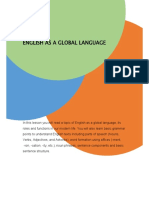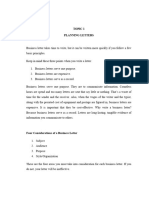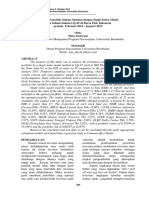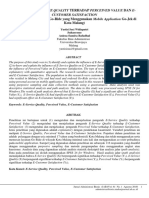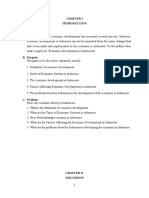Unit 4 - Presentations (The End Is Near... This Is The End)
Unit 4 - Presentations (The End Is Near... This Is The End)
Uploaded by
LK Chiarra PanaliganCopyright:
Available Formats
Unit 4 - Presentations (The End Is Near... This Is The End)
Unit 4 - Presentations (The End Is Near... This Is The End)
Uploaded by
LK Chiarra PanaliganOriginal Title
Copyright
Available Formats
Share this document
Did you find this document useful?
Is this content inappropriate?
Copyright:
Available Formats
Unit 4 - Presentations (The End Is Near... This Is The End)
Unit 4 - Presentations (The End Is Near... This Is The End)
Uploaded by
LK Chiarra PanaliganCopyright:
Available Formats
Unit
4
:
OBJECTIVES:
Structure (3) The end
Summarizing and
concluding
Questions and Discussions
Page 1
PRESENTATIONS: The end is near this is the end
1. Structure (3) The End
1. What does the end of the presentation
contain?
2. What is the difference, if any, between a
summary and a conclusion?
Page 2
PRESENTATIONS: The end is near this is the end
3. Comment on the different approaches
used by two speakers in the cartoons.
Can you suggest reasons for the
different endings?
Page 3
PRESENTATIONS: The end is near this is the end
3. In which of the following situations
do you think a discussion is more
appropriate than questions?
A sales representatives presentation of a
new product.
A Chief Executives statement on corporate
policy.
A politicians speech on transport policy.
A team leaders talk to colleagues on the next
phase of a project.
A managers proposal to a group of senior
executives on improving productivity.
Page 4
PRESENTATIONS: The end is near this is the end
2. Summarizing and
concluding
1. Read the the end of a presentation by
Ben Ingleton, Marketing Director of Foss
Ltd., an agricultural machinery
manufacturer. His talk is about company
valuation.
2. Is this a summary or a conclusion or
is it both? Explain your answer.
Page 5
PRESENTATIONS: The end is near this is the end
Practice 1
Look at the following overhead
transparencies used in a presentation
on safety procedures on an oil platform.
Use them to reconstruct the end of the
presentation.
Begin as follows:
That concludes the main part of my
talk. Now, Id like to
Page 6
PRESENTATIONS: The end is near this is the end
Practice 1
Sample Dialogue
That concludes the main part of my talk. Now I'd
like to summarize the main points. In the past
year, three incidents have shown communication
problems.
In the past five years, 35% of all incidents
contained some degree of communication
problem.
And finally, we have seen that existing
communication procedures are not considered
satisfactory.
Now, turning to my conclusion, I
want to make two key recommendations.
Number one, raining must place more emphasis
on communication procedures.
Number two, there should be a program of
regular revision of these communication
procedures. And that, ladies and gentlemen,
completes my talk.
Page 7
PRESENTATIONS: The end is near this is the end
3. Questions and
Discussion
Page 8
PRESENTATIONS: The end is near this is the end
1 Listen to a recording of two different
ways of ending the same sales
presentation by Marissa Repp about an
automatic warehouse system, the Storo.
Decide if they:
Invite the audience to ask questions
Are a lead in to a discussion
Invite the audience to ask questions and have a
discussion
Request comments
Page 9
PRESENTATIONS: The end is near this is the end
Example 1
So, I've described how the system works.
Now, any questions?
Example 2
I think that covers the main points I
wanted to tell you about ... thank you for
letting me talk about the Storo System.
So ... now ... I'd like to invite you to tell me
about the needs that you have ... to
suggest any specific qualities you need in a
warehousing system ... and at the same
time, if there is anything you are not clear
about, please ask ... if anything needs
clarification.
Page 10
PRESENTATIONS: The end is near this is the end
2 Listen to three examples of possible
endings to other sales presentation. Match
each one to the comments below.
A.A hard sell approach, mainly interested
in selling the product.
B.Weak,
Weak as if the speaker lacks confidence
C.Customer- friendly,
friendly wants to help the
customer.
Page 11
PRESENTATIONS: The end is near this is the end
Example I
A: So, you can see this is just the kind of insurance
you need. Anything you need, we think this policy
can do it. Any questions? ...
So, no questions? Right, thanks for listening.
Example 2
B: That's it then. A totally integrated networked
system ... the best. Now if you've any questions ... I'll
be pleased to try to answer them.
C: Yes, I'd like to know ... Is the programming of
the computer especially complicated? Can the
user make changes easily?
Example 3
D: Now, having told you about the qualities of
the machine, I'd like to hear more about how you
think a packaging system needs to work to meet
your specific situation. Perhaps you could comment
on special needs you will have, specially important
requirements for effective packing, labeling, special
needs ... that sort of thing ...
E: Well, I think the sort of thing we need most ...
our most important thing here is flexibility.
Our packaging changes a lot ...
Page 12
PRESENTATIONS: The end is near this is the end
3 Read the following text and identify:
a.a potential problem at the end of a
presentation
b.three ways to avoid the problem
Page 13
PRESENTATIONS: The end is near this is the end
4 Handling questions is thought by
many speakers to be the most difficult
part of a presentation. Why do you think
this is? How do you think difficulties can
be minimized?
Page 14
PRESENTATIONS: The end is near this is the end
Read Penny Yates script about the
difficulties that can arise in dealing
with questions after a presentation. As
you listen, tick any of the following
pieces of advice that she gives.
Be polite.
Listen very carefully.
Ask for repetition or clarification.
Keep calm.
Tell the truth (most of the time!).
Dont say anything youll regret later.
Check understanding if necessary by
paraphrasing.
Agree partially before giving own opinion.
Yes, but
Page 15
PRESENTATIONS: The end is near this is the end
INTERVI EWER: SO, tell me what you think
is the best way to handle questions after a
presentation.
PENNY: It's very important to listen very
carefully. That's the first thing. Listen. It can
be useful to repeat or paraphrase the question,
you can check it that way, so you repeat the
point the questioner makes. That
can help you, it gives you time to think. You
must always give yourself time. Also, always
ask for clarification if necessary.
INTERVIEWER: What about the answer you
give?
PENNY: Well, tell the truth - most of the
time!
Page 16
PRESENTATIONS: The end is near this is the end
A conference on Land Development in
Europe
included
presentations
on
Financial Support for Business.
Read the 4 extracts of different speakers
handling of questions and discussion. Use
the table below to mark which extracts
are examples of good () or bad ()
technique. Give reasons for your answers.
Technique (/)
Why?
1.
2.
3.
4.
Page 17
PRESENTATIONS: The end is near this is the end
Extract 1
I didn't get that - or if I did - I can't agree. You're
not serious are you? Look, I've been studying this
problem for years and I know what I'm talking
about.
Extract 2
... And that I think is the real reason for the
success of this type of development. Now, if
anyone would like to ask a question, I'll be pleased
to answer ... yes ... the gentleman here.
Extract 3
Yes ... right, I got your question, but I can't answer
it. I've no idea. You'd better ask someone else.
Extract 4
Yes, I think I follow you. Are you saying that there
used to be more government support, but now
this is more difficult? Yes ... that's true, but there's
something else to say about government grants ...
these are often not widely publicized, not
everyone knows what is available ... there may be
tax advantages ...
Page 18
PRESENTATIONS: The end is near this is the end
Page 19
PRESENTATIONS: The end is near this is the end
Page 20
PRESENTATIONS: The end is near this is the end
Page 21
PRESENTATIONS: The end is near this is the end
Page 22
You might also like
- Busines English 2018 PDFDocument48 pagesBusines English 2018 PDFIlham AlfianNo ratings yet
- Tugas Problem Set 4 Ekonomi ManajerialDocument4 pagesTugas Problem Set 4 Ekonomi ManajerialRuth Adriana100% (1)
- Marketing With Meaning - Palak MarwahDocument45 pagesMarketing With Meaning - Palak MarwahsaiNo ratings yet
- Paper V - May 2013Document4 pagesPaper V - May 2013legallyindia0% (1)
- Chads Creative Concepts Case StudyDocument5 pagesChads Creative Concepts Case StudyJoe Nathaniel100% (1)
- FerreroDocument8 pagesFerreroCristina MiaNo ratings yet
- Online PC Learning Invoice GeneratorDocument29 pagesOnline PC Learning Invoice GeneratorpetitfmNo ratings yet
- Chapter 10 - Quality - M1Document2 pagesChapter 10 - Quality - M1hendriekhasanNo ratings yet
- Tugas BIGDocument6 pagesTugas BIGBagas Arya Satya DinataNo ratings yet
- Lesson Plan PPT - BI 2 (Meeting 1)Document20 pagesLesson Plan PPT - BI 2 (Meeting 1)jeany138No ratings yet
- Obligation and Necessity in The PastDocument2 pagesObligation and Necessity in The PastJohn SiregarNo ratings yet
- Unit 1Document12 pagesUnit 1Ringga SaptaNo ratings yet
- Gleaning Information From Financial Statements: ReadingDocument1 pageGleaning Information From Financial Statements: ReadingYanetNo ratings yet
- Match Each Call To The Appropriate Picture Below. in Each Case There Is A CommunicationDocument9 pagesMatch Each Call To The Appropriate Picture Below. in Each Case There Is A CommunicationArianna SafitrisNo ratings yet
- Chap-33, Aggregate - DemandDocument46 pagesChap-33, Aggregate - DemandS. M. SAKIB RAIHAN Spring 20No ratings yet
- Marginal UtilityDocument27 pagesMarginal UtilityfransiskaNo ratings yet
- Chapter Fourteen: Multiple Regression and Correlation AnalysisDocument27 pagesChapter Fourteen: Multiple Regression and Correlation AnalysisyandhiasNo ratings yet
- Meeting 4 - Subsidy - Reading Comprehension and VocabularyDocument16 pagesMeeting 4 - Subsidy - Reading Comprehension and VocabularyAyu PardedeNo ratings yet
- Bab I2 StatistikDocument29 pagesBab I2 Statistikkomarul vadliNo ratings yet
- ENGLISHDocument45 pagesENGLISHmanurunggeorge25No ratings yet
- The Open Economy Revisited: The Mundell-Fleming Model and The Exchange-Rate RegimeDocument47 pagesThe Open Economy Revisited: The Mundell-Fleming Model and The Exchange-Rate Regimeaditya prudhviNo ratings yet
- Jurnal Neraca PembayaranDocument12 pagesJurnal Neraca PembayaranrizkiNo ratings yet
- Wriiting Business Letters in English Fun Activities Games Reading Comprehension Exercis - 15724Document2 pagesWriiting Business Letters in English Fun Activities Games Reading Comprehension Exercis - 15724tiyasNo ratings yet
- English 2-10-Implied QuestionsDocument9 pagesEnglish 2-10-Implied QuestionsDing DongNo ratings yet
- Work With A Partner.: Before You ReadDocument4 pagesWork With A Partner.: Before You ReadMicheleNo ratings yet
- Lani Nuraini MakmurDocument39 pagesLani Nuraini MakmurIlham PandjuNo ratings yet
- EMPOWER Unit 01Document12 pagesEMPOWER Unit 01Ludmila Franca-LipkeNo ratings yet
- Application Letter: Name: Ajeng Putri Aprilia Class: XII Social 1Document3 pagesApplication Letter: Name: Ajeng Putri Aprilia Class: XII Social 1tamara reginaNo ratings yet
- Mid Term Exam Tommy 223402516263Document8 pagesMid Term Exam Tommy 223402516263Tommy.No ratings yet
- Academic English Grammar in UseDocument34 pagesAcademic English Grammar in Usecleonie annissaNo ratings yet
- The Ralph Corporation Cost of Goods Manufactured Statement December 31, 19 XXDocument2 pagesThe Ralph Corporation Cost of Goods Manufactured Statement December 31, 19 XXAshari Psi0% (1)
- BUKU Bahasa Inggris 1-2Document86 pagesBUKU Bahasa Inggris 1-2Dewiprm sNo ratings yet
- Exercise 1: Name: Griseldaindya IW Class: 2A D3 Teknik Listrik NIM: 32118009Document2 pagesExercise 1: Name: Griseldaindya IW Class: 2A D3 Teknik Listrik NIM: 32118009Intan Ayu KurniaNo ratings yet
- Ulangan Tengah Semester - Atmaka Ivan - R1J - 202146500748Document6 pagesUlangan Tengah Semester - Atmaka Ivan - R1J - 202146500748MAJELIS DISSERTNo ratings yet
- Peranggaran - #7 Anggaran Tenaga KerjaDocument28 pagesPeranggaran - #7 Anggaran Tenaga Kerjacitra kurniaNo ratings yet
- DIFERENSIAL SederhanaDocument57 pagesDIFERENSIAL SederhanaLagaSuksesUasbn100% (1)
- Ec Chapter 3Document13 pagesEc Chapter 3Sefa AnjaniNo ratings yet
- English 1 - Meeting 2 - Structure PonounsDocument11 pagesEnglish 1 - Meeting 2 - Structure Ponounsnapsanmep dsgNo ratings yet
- Maria Melayanti - Quiz - Tenses (Beginner)Document3 pagesMaria Melayanti - Quiz - Tenses (Beginner)Ferdy Ricardo SinagaNo ratings yet
- Contoh Soal Bhs InggrisDocument5 pagesContoh Soal Bhs InggrisSofyanNo ratings yet
- 277 550 2 PB PDFDocument34 pages277 550 2 PB PDFEntar SutismanNo ratings yet
- Istilah Ekonomi Dalam Bahasa InggrisDocument3 pagesIstilah Ekonomi Dalam Bahasa InggrisJuharNo ratings yet
- Handling OrderDocument16 pagesHandling OrderAnggaNo ratings yet
- Structure OK PDFDocument96 pagesStructure OK PDFleedaridhaNo ratings yet
- Assignment of Making Request and Asking For PDocument2 pagesAssignment of Making Request and Asking For PPramesti Hajar Budi Hapsari100% (1)
- Dokumen - Tips - Meeting 1 NounsDocument5 pagesDokumen - Tips - Meeting 1 NounsMila WdyntNo ratings yet
- Tugas Compare Dan ContrastDocument4 pagesTugas Compare Dan ContrastIndah ameliaNo ratings yet
- 11Document8 pages11Surya AfNo ratings yet
- Kuesioner Penelitian Teh PociDocument2 pagesKuesioner Penelitian Teh PociHendy prasetyoNo ratings yet
- 104 P11Document13 pages104 P11Yoga Nur IkhsanNo ratings yet
- Positioning MapsDocument5 pagesPositioning MapsthuanvltkNo ratings yet
- AkuntansiDocument87 pagesAkuntansipuput indah sariNo ratings yet
- Silabus Matematika Keuangan 260221Document5 pagesSilabus Matematika Keuangan 260221Garcia ZarathustraNo ratings yet
- Tugas Bahasa InggrisDocument5 pagesTugas Bahasa InggrisRyo BastianNo ratings yet
- Pengaruh E-Service Quality Terhadap Perceived Value Dan E - (Survei Pada Pelanggan Go-Ride Yang Menggunakan Mobile Application Go-Jek Di Kota Malang)Document10 pagesPengaruh E-Service Quality Terhadap Perceived Value Dan E - (Survei Pada Pelanggan Go-Ride Yang Menggunakan Mobile Application Go-Jek Di Kota Malang)m.knoeri habibNo ratings yet
- Jawaban Studi Kasus 5 Level 1Document24 pagesJawaban Studi Kasus 5 Level 1Setifani PrihassariNo ratings yet
- Unit 3. Different Economic Systems: Text ADocument4 pagesUnit 3. Different Economic Systems: Text Amahda lena100% (1)
- Makalah Perkembangan Ekonomi Di IndonesiaDocument9 pagesMakalah Perkembangan Ekonomi Di IndonesiaPapua NetNo ratings yet
- Unit 5 - Advertising PDFDocument5 pagesUnit 5 - Advertising PDFMuhammad Ainul RoziqinNo ratings yet
- Quiz 3 Level: Easy: A) WhereDocument3 pagesQuiz 3 Level: Easy: A) WhereNurmaulidinaNo ratings yet
- English 1 - Meeting 5 - Structure Future and ModalsDocument15 pagesEnglish 1 - Meeting 5 - Structure Future and Modalsnapsanmep dsgNo ratings yet
- Makalah Character BuildingDocument16 pagesMakalah Character BuildingRatna AjhaNo ratings yet
- English 1 2018Document54 pagesEnglish 1 2018RayNo ratings yet
- Unit 9: The End Is Near.. This Is The EndDocument20 pagesUnit 9: The End Is Near.. This Is The EndNguyễn Hồng Trang100% (1)
- Chapter 1Document10 pagesChapter 1Shofika Sani AzzahrahNo ratings yet
- Essential Grammar (Units 47)Document8 pagesEssential Grammar (Units 47)LK Chiarra Panaligan0% (1)
- Mox's Shop - PhonicsDocument22 pagesMox's Shop - PhonicsLK Chiarra PanaliganNo ratings yet
- Gus The DuckDocument20 pagesGus The DuckLK Chiarra PanaliganNo ratings yet
- Unit 6 - Sorry To Interrupt, But...Document25 pagesUnit 6 - Sorry To Interrupt, But...LK Chiarra Panaligan50% (2)
- Unit 1 - Presentations (Planning and Getting Started)Document19 pagesUnit 1 - Presentations (Planning and Getting Started)LK Chiarra PanaliganNo ratings yet
- Lesson 1 - Telephoning (Part 1)Document12 pagesLesson 1 - Telephoning (Part 1)LK Chiarra PanaliganNo ratings yet
- Unit 2 - Presentations (Image, Impact and Making An Impression) 2Document25 pagesUnit 2 - Presentations (Image, Impact and Making An Impression) 2LK Chiarra Panaligan100% (1)
- Foundations of Education 1 (LEARNING)Document28 pagesFoundations of Education 1 (LEARNING)LK Chiarra PanaliganNo ratings yet
- PororoDocument4 pagesPororoLK Chiarra Panaligan100% (1)
- Language Functions 2Document19 pagesLanguage Functions 2LK Chiarra Panaligan100% (1)
- MoGen Inc Case Study Analysis StepDocument10 pagesMoGen Inc Case Study Analysis Stepanon_124852542No ratings yet
- Direct Exporting and Indirect ExportingDocument18 pagesDirect Exporting and Indirect ExportingKanishka PanwarNo ratings yet
- Persons. - in Ascertaining The Correctness of Any Return, or in Making A Return When None Has Been Made, or inDocument68 pagesPersons. - in Ascertaining The Correctness of Any Return, or in Making A Return When None Has Been Made, or inPatriotic PilipinoNo ratings yet
- Invoice Nr. 267-2023Document7 pagesInvoice Nr. 267-2023Md. Nazrul IslamNo ratings yet
- Barzaga V CADocument1 pageBarzaga V CAEiffel Usman MarrackNo ratings yet
- Commerce: Scheme of ExaminationDocument14 pagesCommerce: Scheme of ExaminationMr DamphaNo ratings yet
- Reliance RetailDocument1 pageReliance RetailKalicharan PuriNo ratings yet
- Buenaventura Angeles Vs Ursula Torres Calasanz, Et Al., Case DigestDocument2 pagesBuenaventura Angeles Vs Ursula Torres Calasanz, Et Al., Case DigestLien Lee100% (1)
- Coca-Cola Strategic PlanDocument17 pagesCoca-Cola Strategic Planapi-326272121100% (1)
- Jeremy ResumeDocument2 pagesJeremy Resumeapi-258650429No ratings yet
- Model 9400 Drill PressDocument4 pagesModel 9400 Drill PressmkaukolaNo ratings yet
- Accounting Information System For Merchandising BusinessDocument14 pagesAccounting Information System For Merchandising BusinessJubert Ng0% (1)
- CBSE Class 10 Elements of Business Marking Scheme Question Paper 2020-21Document7 pagesCBSE Class 10 Elements of Business Marking Scheme Question Paper 2020-21Veggalam Shiva kumarNo ratings yet
- Cost of Project & Break-Even AnalysisDocument28 pagesCost of Project & Break-Even AnalysisRs rsNo ratings yet
- W3 AssignmentDocument6 pagesW3 AssignmentRizky AkbarNo ratings yet
- DMGT403 AccountingDocument20 pagesDMGT403 Accountinghemant kumar100% (1)
- Effect of E-Procurement On Internal and External Customer ServicesDocument77 pagesEffect of E-Procurement On Internal and External Customer Servicessatish_sggs100% (6)
- Brand Awareness - HeritageDocument57 pagesBrand Awareness - HeritageVasavi Daram100% (2)
- Management Giant: Lord Thomson of Fleet (Roy Thomson)Document4 pagesManagement Giant: Lord Thomson of Fleet (Roy Thomson)hdfcblgoaNo ratings yet
- GST-Test Paper FormatDocument2 pagesGST-Test Paper FormatManisha ChaturvediNo ratings yet
- Johannes Schuback v. Court of AppealsDocument2 pagesJohannes Schuback v. Court of AppealsHezro100% (1)
- Invoice FANDocument1 pageInvoice FANVarsha A Kankanala0% (1)
- Irony in The Requiem in Death of A SalesmanDocument5 pagesIrony in The Requiem in Death of A SalesmanSanad AllihyanyNo ratings yet
- Understanding Stock Market TermsDocument6 pagesUnderstanding Stock Market TermsicdiazNo ratings yet
- Consumer LearningDocument35 pagesConsumer LearningdurgeshagnihotriNo ratings yet











